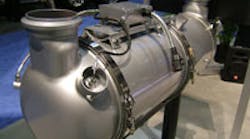So, I‘m sitting in this cavernous meeting room cheek-by-jowl with reporters and fleet managers at the Technology & Maintenance Council‘s annual meeting, trying to make sense of what I‘m hearing about a series of onboard diagnostic (OBD) requirements that are going to be implemented starting in 2010 through 2019.
Truth be told, 90% of what‘s being discussed is going straight over my head at VERY high altitude, like a B-1 bomber going supersonic. All the speakers I‘m listening to - such as Keith Doorenbos, manager of electronics and electrical engineering at Kenworth Truck Co., Greg Gillham, Detroit Diesel‘s manager-OBD for heavy engines, and Ben Zwissler, chief engineer-OBD systems for Cummins Inc., just to name a few - are talking in a language I can barely grasp.
There are charts and graphs displaying rates of emission flow, electronic degradation, and other extremely technical data that used to give me nightmares back in college as I struggled through the most basic of coursework in physics (how I, a lowly history major, managed to pass at all is still a mystery to me.)
Despite the jargon and the math, however, these experts were explaining something that‘s going to have huge ramifications to the trucking industry. Cummins‘ Zwissler put it this way: “What‘s being required of us is to develop extremely sensitive sensors that can detect excessive NOx [oxides of nitrogen] and PM [particulate matter] at very low levels. That means these sensors are going to be more complex - and thus have a higher risk of faults. That‘s going to make the maintenance folk‘s life more challenging.”
(Now THERE is an understatement!)
What‘s going on is that, starting in 2010, specific rules kick in dictating “good” and “bad” thresholds for the pollutants NOx and PM in the exhaust system of trucks. In 2010, the feds want these “detections sensors” to indicate when those emissions reach five times the acceptable level. In 2013, that threshold gets ratcheted down to three times the acceptable level - with these thresholds continuing to drop through 2019.
(A diesel particulate filter [DPF] that'll be host to these new sensors)
Yet right now, the industry only has sensors capable of detecting an eight- to 10-time overage - meaning there‘s a long way to go in terms of meeting the technological standards the federal government (and California, for that matter) has established.
What these sensors are going to do is trip the “MIL” light on the truck‘s dashboard - an acronym for “malfunction indicator lamp.” If the emission levels get too high, that light comes on, telling the engine to start slowing down and eventually stopping over a period of time, since it‘s producing too much pollution.
(There's new things going on engine-wise, too: here's a video update on Detroit Diesel's new DD15 engine, which is the platform it'll use to comply with 2010 emission regulations.)
Now, you know what comes next - a sensor fails, the light comes on, and BOOM! You have a truck stranded on the side of the road due to an electrical failure. That‘s the concern these engineers have and one they are working very hard to eliminate.
“How we detect a sensor failure is going to be crucial,” said Tim Gundrum from International Truck & Engine Co. “They control the emission system, so we‘ll need diagnostic strategies that will correct sensor errors yet not allow excessive pollution.”
Now, these rules won‘t be applied to all diesel engines at once. Rather, they‘ve go into effect by engine “family” in progressive fashion, starting with the lowest displacement and finishing with the big bore models (13 and 15 liter, and up.) Hopefully, that slow application will give the engineers time to correct technological glitches that crop up along the way.
(A view of Detroit Diesel's new DD15 engine)
But make no mistake: these little sensors are going to complicate things for truckers of all stripes. “These rules are truly game changing,” said Kenworth‘s Doorenbos. “We‘re dealing with a whole range of issues here, from sensor reliability to diagnostic accuracy and development timelines. It‘s going to make things very challenging.”



